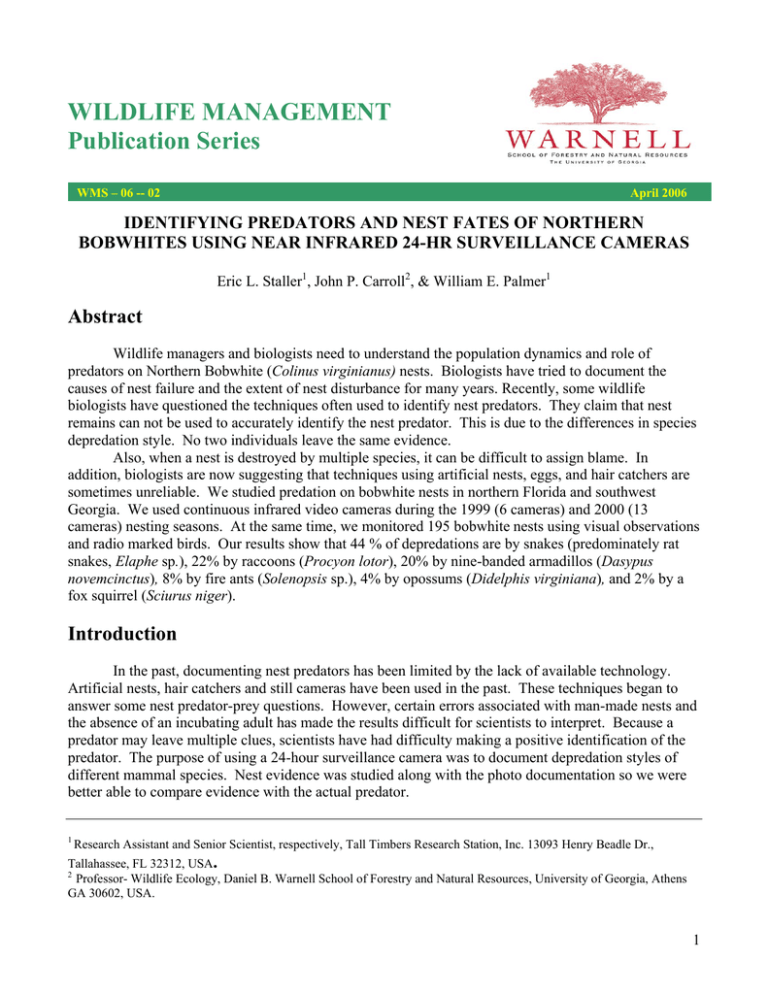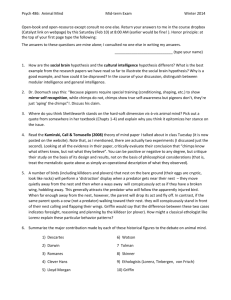WILDLIFE MANAGEMENT Publication Series
advertisement

WILDLIFE MANAGEMENT Publication Series WMS – 06 -- 02 April 2006 IDENTIFYING PREDATORS AND NEST FATES OF NORTHERN BOBWHITES USING NEAR INFRARED 24-HR SURVEILLANCE CAMERAS Eric L. Staller1, John P. Carroll2, & William E. Palmer1 Abstract Wildlife managers and biologists need to understand the population dynamics and role of predators on Northern Bobwhite (Colinus virginianus) nests. Biologists have tried to document the causes of nest failure and the extent of nest disturbance for many years. Recently, some wildlife biologists have questioned the techniques often used to identify nest predators. They claim that nest remains can not be used to accurately identify the nest predator. This is due to the differences in species depredation style. No two individuals leave the same evidence. Also, when a nest is destroyed by multiple species, it can be difficult to assign blame. In addition, biologists are now suggesting that techniques using artificial nests, eggs, and hair catchers are sometimes unreliable. We studied predation on bobwhite nests in northern Florida and southwest Georgia. We used continuous infrared video cameras during the 1999 (6 cameras) and 2000 (13 cameras) nesting seasons. At the same time, we monitored 195 bobwhite nests using visual observations and radio marked birds. Our results show that 44 % of depredations are by snakes (predominately rat snakes, Elaphe sp.), 22% by raccoons (Procyon lotor), 20% by nine-banded armadillos (Dasypus novemcinctus), 8% by fire ants (Solenopsis sp.), 4% by opossums (Didelphis virginiana), and 2% by a fox squirrel (Sciurus niger). Introduction In the past, documenting nest predators has been limited by the lack of available technology. Artificial nests, hair catchers and still cameras have been used in the past. These techniques began to answer some nest predator-prey questions. However, certain errors associated with man-made nests and the absence of an incubating adult has made the results difficult for scientists to interpret. Because a predator may leave multiple clues, scientists have had difficulty making a positive identification of the predator. The purpose of using a 24-hour surveillance camera was to document depredation styles of different mammal species. Nest evidence was studied along with the photo documentation so we were better able to compare evidence with the actual predator. 1 Research Assistant and Senior Scientist, respectively, Tall Timbers Research Station, Inc. 13093 Henry Beadle Dr., Tallahassee, FL 32312, USA. 2 Professor- Wildlife Ecology, Daniel B. Warnell School of Forestry and Natural Resources, University of Georgia, Athens GA 30602, USA. 1 EQUIPMENT We used a MICROCAM™ 24-hour infrared surveillance camera. The camera is connected to a VHS-VCR by about 100 feet of cable. The VCR is powered by a marine deep-cycle battery. Video recording equipment Infrared camera near quail nest Camera fully disguised and positioned near nest METHODS Bobwhites were fitted with necklace radio transmitters during the fall and winter months of 1998 and 1999. Nests were found through daily locations using radio telemetry. Cameras were set near nests and camouflaged while the bobwhite was off the nest feeding. Tapes and batteries were changed every day. STUDY SITES The "Red Hills" region is in the Gulf Coastal Plain in Florida and Georgia. Study sites are composed of upland Southern pine forests ranging from longleaf pine (Pinus palustris) and wire grass (Arsitida sticta) (Figure 1) to Loblolly pine (Pinus taeda) and old field vegetation. Sites did not have predator control programs. The study areas were burned each year to promote herbaceous ground cover. Scattered throughout the study sites are hardwood drains/hammocks and fallow fields 0.6 to 2.5 ac in size that are maintained with annual disturbance. Early fall quail densities were estimated to be as high as a bird per acre or as low as a bird per 3 acres. RESULTS Cameras were set on 195 wild quail nest. Nesting success was about the same between camera nests and non-camera nests. Nesting success in our study was about the same as with past nesting success at these study sites. Most of the nest depredations were caused by snakes (44%). Mammals commonly thought to be most important destroyed only 26% of nests. The nine-banded armadillo was an important mammalian predator. All the results are shown in Figure 2. Multiple depredations (more than one nest predator) occurred on only 10% of the destroyed nests. One nest was visited by a five different predator species. Other nest predators include raccoons, opossums, fox, cotton rats, and coyote. 2 Figure 1. Typical habitat for northern bobwhite quail in South Georgia. Nest predators in Red Hills region Florida and Georgia Fox squirrel 2% Opposum 4% Fire ants 8% Armadillo 20% Snake 44% Raccoon 22% Figure 2. The predators responsible for the documented destruction of 195 monitored quail nests in southwest Georgia and north Florida during 1999-2000. IMPLICATIONS OF RESEARCH The results of our research on quail nest predators have led to the following conclusion: ¾ Depredation on quail nests is more complicated than previously realized. 3 ¾ Our camera system seems to be less biased than those previously used to monitor predation on ground nesting birds. ¾ Our results may impact legislation directed at the management of mammalian predators. ¾ This system will provide a better understanding of nest-predators and quail. Raccoon depredating a quail nest. Southern fox squirrel eating quail eggs. ACKNOWLEDGMENTS This study was funded Tall Timbers Research Station, University of Georgia Warnell School of Forestry and Natural Resources, and McIntire-Stennis GEO-100. EDITOR Michael T. Mengak, Associate Professor – Wildlife Specialist Warnell School of Forestry and Natural Resources Athens, Georgia 30602-2152 Telephone 706.542.2686 Fax 706.542.8356 In compliance with federal law, including the provisions of Title IX of the Education Amendments of 1972, Title VI of the Civil Rights Act of 1964, Sections 503 and 504 of the Rehabilitation Act of 1973, and the Americans with Disabilities Act of 1990, the University of Georgia does not discriminate on the basis of race, sex, religion, color, national or ethnic origin, age, disability, or military service in its administration of educational policies, programs, or activities; its admissions policies; scholarship and loan programs; athletic or other University-administered programs; or employment.. In addition, the University does not discriminate on the basis of sexual orientation consistent with the University non-discrimination policy.. Inquiries or complaints should be directed to the director of the Equal Opportunity Office, Peabody Hall, 290 South Jackson Street, University of Georgia, Athens, GA 30602.Telephone 706-542-7912 (V/TDD).Fax 706-542-2822 4






